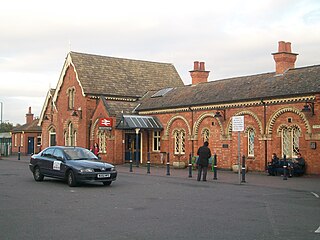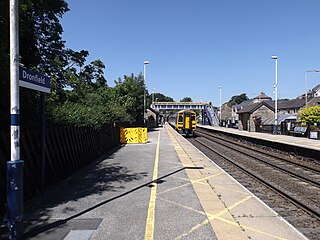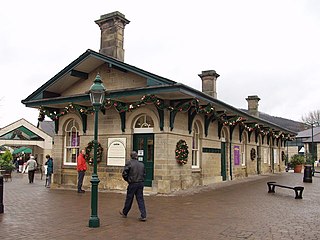
The London, Midland and Scottish Railway (LMS) was a British railway company. It was formed on 1 January 1923 under the Railways Act of 1921, which required the grouping of over 120 separate railways into four. The companies merged into the LMS included the London and North Western Railway, Midland Railway, the Lancashire and Yorkshire Railway, several Scottish railway companies, and numerous other, smaller ventures.

Sheffield station, formerly Pond Street and later Sheffield Midland, is a combined railway station and tram stop in Sheffield, England, and the busiest station in South Yorkshire. Adjacent is Sheffield station/Sheffield Hallam University Sheffield Supertram stop. In 2017–18, the station was the 43rd-busiest in the UK, and the 15th-busiest outside London.

Chesterfield railway station serves the town of Chesterfield in Derbyshire, England. It lies on the Midland Main Line. Four tracks pass through the station which has three platforms. It is currently operated by East Midlands Railway.

Derby railway station is a main line railway station serving the city of Derby in Derbyshire, England. Owned by Network Rail and managed by East Midlands Railway, the station is also used by CrossCountry services and two daily Northern services.

Matlock Bath railway station is a Grade II listed railway station owned by Network Rail and managed by East Midlands Railway. It is located in the village of Matlock Bath in Derbyshire, England. The station is unmanned by rail staff and is located on the Derwent Valley Line, 16.25 miles (26.15 km) north of Derby towards Matlock.

Matlock Railway Station is a railway station owned by Network Rail and managed by East Midlands Railway in the Derbyshire Dales town of Matlock, Derbyshire, England. The station is the terminus of both the Derwent Valley Line from Derby and Peak Rail who operate heritage services to Rowsley South. Both lines are formed from portions of the Midland Railway's former main line to Manchester Central. Through running is technically possible but is not done in normal service.

Wellingborough railway station is a Grade II listed station located in the market town of Wellingborough in Northamptonshire, England. It lies on the Midland Main Line and is 65 miles (104 km) from London St. Pancras. The station is operated by East Midlands Railway, which is also the primary operator serving the station with passenger services.

Long Eaton railway station serves the town of Long Eaton in Derbyshire, England. It lies on the Midland Main Line and the Derby-Nottingham line 120 miles 28 chains (193.7 km) north of London St Pancras. The station is managed by East Midlands Railway, but CrossCountry operates some services.

Dronfield railway station serves the town of Dronfield in Derbyshire, England, south of Sheffield, on the Midland Main Line between Chesterfield and Sheffield.

Burton-on-Trent railway station is a mainline railway station located in the town of Burton upon Trent, Staffordshire, England. It is owned by Network Rail and managed by East Midlands Railway, although only CrossCountry services call at the station.

Draycott railway station was a station which served the village of Draycott, Derbyshire, England. It was located on the south side of Station Road.

The Melbourne Line was a railway line which ran from Derby to Ashby de la Zouch. It was used by the British Army and Allied engineers during the Second World War from 1939 until late 1944 to prepare them for the invasion of mainland Europe. Engineers practised the demolition and rebuilding of railways and the running and maintenance of a railway line and its rolling stock. There was also a bridge building school at Kings Newton.

Shottle railway station is the second intermediate station on the former Midland Railway branch line to the small town of Wirksworth in Derbyshire. The line is off the Midland Main Line at Duffield railway station, the first being Hazelwood.

Idridgehay railway station is an intermediate station on the former Midland Railway branch line to the town of Wirksworth in Derbyshire. The line is off the Midland Main Line at Duffield. The line has been reopened as the Ecclesbourne Valley Railway and Idridgehay station was reopened on 8 March 2008.

Melbourne railway station was a station at Kings Newton that served the adjacent town of Melbourne, Derbyshire, England.

Gresley railway station was a railway station at Castle Gresley, Derbyshire on the Leicester to Burton upon Trent Line.

The original Rowsley railway station was opened in 1849 by the Manchester, Buxton, Matlock and Midlands Junction Railway to serve the village of Rowsley in Derbyshire.
Denis Dunlop (1892–1959) was a sculptor working throughout England during the first half of the 20th century. His work is instantly identifiable for the bold use of stylised Art Deco forms, breath-taking attention to detail and ingenious composition.
William Henry Hamlyn FRIBA was an architect based in England noted for his buildings for the London Midland and Scottish Railway.

The Midland Hotel, also known as Hallmark Hotel Derby Midland, is a hotel on Midland Road in Derby in the East Midlands of England, adjacent to Derby railway station. It is the oldest extant purpose-built station hotel in the world.




















